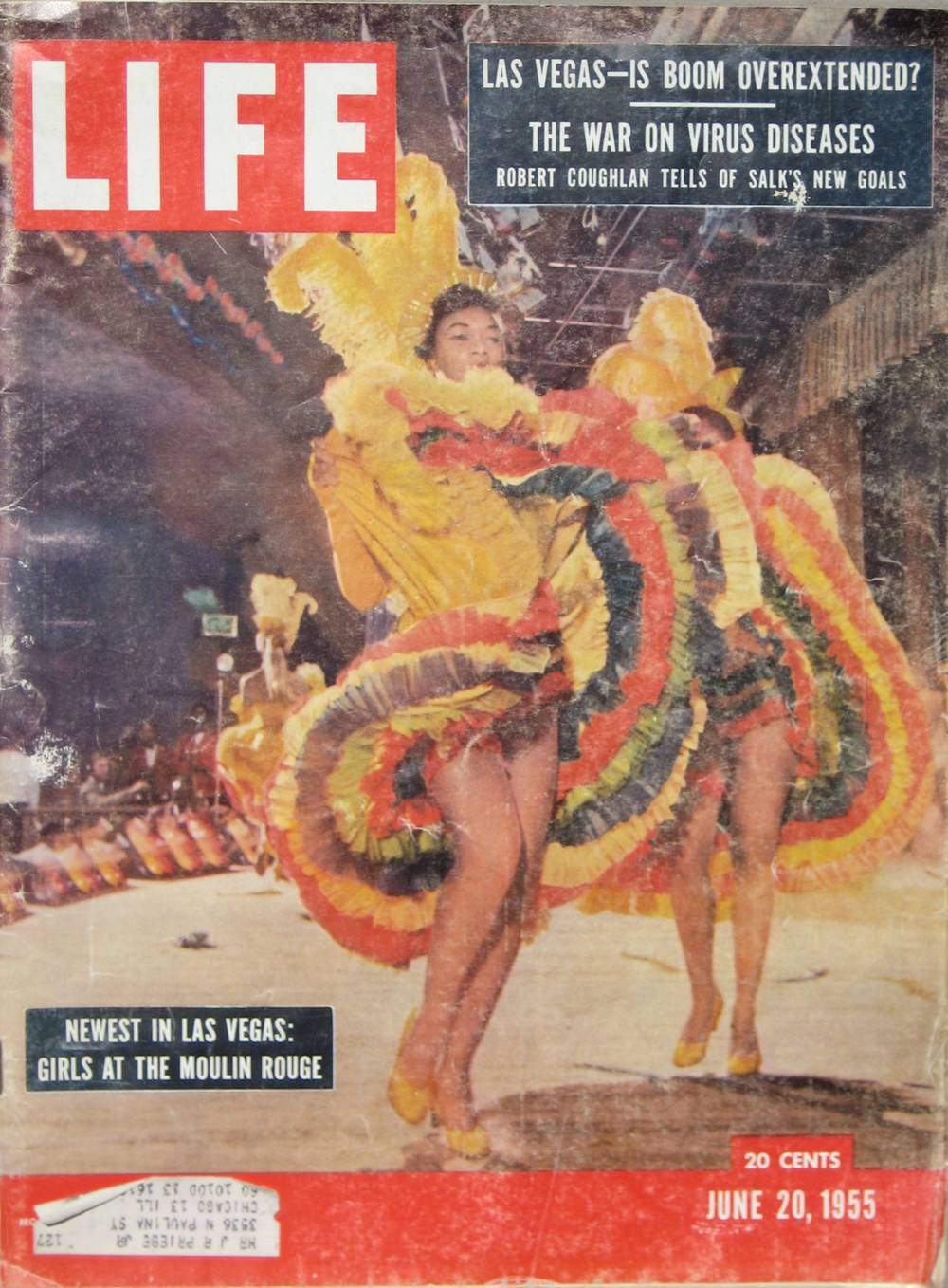
Every now and again, if you’re around Vegas long enough, you hear about the June 20, 1955 issue of Life Magazine with a Moulin Rouge showgirl on its cover. The issue is, to many, the “Dewey Defeats Truman” moment for Vegas journalism for the question its headline asked:
“Las Vegas—Is Boom Overextended?”
It’s a punchline to many on the Strip. Six months ago, Sheldon Adelson himself referenced it in an interview in advance of the Palazzo opening in response to my question about whether the city could be overbuilt. The implication was that almost since the dawn of the destination, naysayers have wondered whether the city could continue to sustain its own urge to constantly grow.
The reason I bring this up is because, by some quirk of fate, I found a copy of that very issue for sale for a mere $25 at the Casino Chip and Gaming Tokens Collectors Club convention at the Riviera last week. I’d bought a copy before, but it was sealed in plastic and never read; the fact that I now had a shot at another copy, unwrapped, on the exact 53rd anniversary of its publication was a minor thrill I couldn’t refuse.
It also took on more resonance this year because Vegas is in one of its worst slumps ever. Occupancy and room rates are down, gambling revenues are on track to fall for only the second time since 1970, the last time being in 2002 following 9/11.
At the very same time, the frantic building continues unabated. The various CityCenter structures, the Fontainebleau, Wynn’s Encore, Echelon and a new Caesars tower all are poised to add more than 19,000 high-end rooms to the already staggering inventory in the next couple of years. Now Adelson is looking at moving the Sands Expo Center elsewhere to make room for 7,000 more rooms, Wynn wants another 5,000 in place of his golf course, Station Casinos wants 10,000 more just west of the Strip in its Viva project and someone—maybe the Plaza folks, maybe not—is going to do something big on the former Frontier property.
Which brings us back to where Las Vegas was in 1955 when that seemingly foolish headline and article were written.
“The preparation for the boom had been stupendous. Three hotels costing a total of $15 million opened in the spring of 1955,” the article explained. “All of them had air-conditioned rooms, oddly shaped swimming pools, excellent cuisines, fabulous nightclub entertainment—and, of course, gambling rooms for which all these other attractions were simply come-ons. … Then, to top this, in the past month two new hotels opened,” the $5 million Dunes and the Moulin Rouge. Seven more resorts were scheduled to be built, the story said. There are photos of a bored croupier at the Dunes two weeks after opening night, a shot of the Dunes’ empty pool.
Oh, what silliness! It all worked out in the long run, didn’t it now? Gambling revenues never actually declined in all those years, we’re reminded.
Well, sort of. But rather than guffaw at the negativism represented, I wondered if the Vegas of 1955 had any lessons for us. Life Magazine back then wasn’t in the business of being stupid; there had to be a reason they wondered, and, in the piece itself, it indicates the proposition that the city was overextended was “asked mostly by the newer hotels.”
So what really happened?
A lot of people lost a lot of money very quickly. And not the customers.
“There was a wave of bankruptcies,” recalled Dave Schwartz, director of UNLV’s Center for Gaming Research and author of, among other great Vegas history books, Suburban Xanadu: The Casino Resort on the Las Vegas Strip and Beyond. “The Dunes, the Riviera, the Royal Nevada, the Frontier, the Moulin Rouge, a lot of the new places ran into trouble.”
The difference now, Schwartz noted, is that the resorts that will be hurt by this coming onslaught—and believe me, there will be blood—won’t be the new stuff but the old. Except that the old stuff is mostly owned by the folks building the new stuff, so where does that leave us?
What’s telling is that Vegas faced that downturn in the mid-1950s when Las Vegas had none of the real challenges it faces today. Gasoline was just 23 cents a gallon back then, which, adjusted for inflation, still would only be about $1.76 today. The only place to legally gamble in the United States was Nevada. The casino-hotels were just beginning to reach out to conventioneers to gin up mid-week traffic.
Today’s Las Vegas is running out of new tricks, is being slaughtered by gas prices that are probably over $4 for good now, has intense competition not just for gambling but also for resort and show experiences across the nation. We’ve mastered the convention world, we’ve conquered the culinary universe, we’ve perfected the opulent room. Back then they were already trying to wean customers off of gambling, to diversify. Today, 60 percent of revenue comes from non-gaming sources.
Is making it even more expensive and, thus, exclusive, really a recovery plan?
I’m not a negativist. I’m a realist. Can Las Vegas be overbuilt? Of course it can. And, in fact, it has been in the past. It was in 1955. It took years to absorb all of its new product, and those years meant many people lost a lot of money in the interim.
Again from the Life piece: “For more than a decade, [Las Vegas] had parlayed one prosperous year into a more prosperous next year and went into the expansion more in the spirit of hunch than of calculated economics.”
Sounds familiar, no?
Head to ReadVegas.com to read Steve Friess’ daily blog, Vegas Happens Here, or catch his weekly celeb-interview podcast, The Strip.








Previous Discussion: